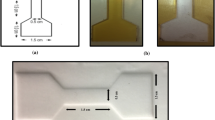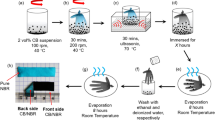Abstract
Materials that change resistance after undergoing deformation have various types of applications as sensors. Among the materials that may be used for this purpose, there are some in which conducting particles are immersed in an isolating polymeric matrix. Carbon black (CB) particles have high electrical conductivity, allowing them to be included in a resin epoxy (EPX) matrix and resulting in an electrical conductor composite; this can be done even in the case of low volumetric fractions of CB. The goal of this work was crafting a conducting polymeric film that has piezoresistive behavior for utilization as strain sensors for low deformations. A relevant aspect of the film development was the search for a solvent to lower the viscosity of the EPX to enhance the homogeneity of the composite. Acetone showed good potential as the solvent for this composite. The sensor showed efficiency under small strain, especially when used with a substrate.










Similar content being viewed by others
References
Canavese G, Stassi S, Stralla M, Bignardi C, Pirri CF (2012) Stretchable and conformable metal–polymer piezoresistive hybrid system. Sens Actuators A Phys 186:191–197
Bloor D, Donnelly K, Hands PJ, Laughlin P, Lussey D (2005) A metal–polymer composite with unusual properties. J Phys D Appl Phys 38:2851–2860
Han BG, Han BZ, Ou JP (2009) Experimental study on use of nickel powder-filled Portland cement-based composite for fabrication of piezoresistive sensors with high sensitivity. Sens Actuators A Phys 149:51–55
Han BG, Yu Y, Ha BZ, Ou JP (2008) Development of a wireless stress/strain measurement system integrated with pressure-sensitive nickel powder-filled cement-based sensors. Sens Actuators A Phys 147:536–543
Han BG, Han BZ, Yu X (2010) Effects of the content level and particle size of nickel powder on the piezoresistivity of cement-based composites/sensors. Smart Mater Struct 19:065012
Sandler J, Shaffer MSP, Prasse T, Bauhofer W, Schulte K, Windle AH (1991) Development of a dispersion process for carbon nanotubes in an epoxy matrix and the resulting electrical properties. Polymer 40:5967–5971
Ounaies Z, Park C, Wise KE, Siochi EJ, Harrison JS (2003) Electrical properties of single wall carbon nanotube reinforced polyimide composites. Compos Sci Technol 63:1637–1646
Azhari F, Banthia N (2012) Cement-based sensors with carbon fibers and carbon nanotubes for piezoresistive sensing. Cem Concrete Compos 34:866–873
Dang Z, Jiang M, Xie D, Yao S, Zhang L, Bai J (2008) Supersensitive linear piezoresistive property in carbon nanotubes/silicone rubber nanocomposites. J Appl Phys 104:024114
Wang L, Cheng L (2014) Piezoresistive effect of a carbon nanotube silicone-matrix composite. Carbon 71:319–331
Wang L, Xu C, Li Y (2013) Piezoresistive response to changes in contributive tunneling film network of carbon nanotube/silicone rubber composites under multi-load/unload. Sens Actuators A Phys 189:45–54
Zetina-Hernández O, Duarte-Aranda S, May-Pat A, Canché-Escamilla G, Uribe-Calderon J, Gonzalez-Chi PI, Avilés F (2013) Coupled electro-mechanical properties of multiwall carbon nanotube/polypropylene composites for strain sensing applications. J Mater Sci 48(21):7587–7593
Fung CK, Zhang MQ, Chan RH, Li WJ (2005) A PMMA-based micro pressure sensor chip using carbon nanotubes as sensing elements. In: 18th IEEE international conference on micro electro mechanical systems (MEMS 2005), pp 251–254
Makireddi S, Shivaprasad S, Kosuri G, Varghese FV, Balasubramaniam K (2005) Electro-elastic and piezoresistive behavior of flexible MWCNT/PMMA nanocomposite films prepared by solvent casting method for structural health monitoring applications. Compos Sci Technol 118:101–107
Wichmann MH, Buschhorn ST, Gehrmann J, Schulte K (2009) Piezoresistive response of epoxy composites with carbon nanoparticles under tensile load. Phys Rev B 80(24):245437
Chung DDL (2000) Cement reinforced with short carbon fibers: a multifunctional material. Compos B 31:511–526
Chung DDL (2000) Cement-matrix composites for smart structures. Smart Mater Struct 9:389–401
Paleo AJ, Van Hattum FWJ, Pereira J, Rocha JG, Silva J, Sencadas V, Lanceros-Méndez S (2010) The piezoresistive effect in polypropylene–carbon nanofibre composites obtained by shear extrusion. Smart Mater Struct 19(6):065013
Wang X, Chung DDL (1998) Short carbon fiber reinforced epoxy coating as a piezoresistive strain sensor for cement mortar. Sens Actuators A Phys 71(3):208–212
Ding T, Wang L, Wang P (2007) Changes in electrical resistance of carbon-black-filled silicone rubber composite during compression. J Polym Sci B Polym Phys 45(19):2700–2706
Wu G, Asai S, Cheng Z, Miura T, Sumita M (2000) A delay of percolation time in carbon-black-filled conductive polymer composites. J Appl Phys 88:1480
Yang QQ, Liang JZ (2008) A percolation model for insulator–metal transition in polymer–conductor composites. Appl Phys Lett 93:131918
Schueler R, Petermann J, Schulte K, Wentzel H (1997) Agglomeration and electrical percolation behavior of carbon black dispersed in epoxy resin. Appl Polym Sci 63:1741–1746
Oh J, Oh K, Kim C, Hong C (2004) Desing of radar absorbing structures using glass/epoxy composites containing carbon black in X-band frequency ranges. Compos B 35:46–56
Narkis M, Ram A, Flashner F (1978) Electrical properties of carbon black filled polyethylene. Polym Eng Sci 18:649–653
Calleja FJB, Bayer RK, Ezquerra TA (1988) Electrical conductivity of polyethylene–carbon–fiber composites mixed with carbon black. J Mater Sci 23:1411–1415
Kost J, Narkis M, Foux A (1984) Resistivity behavior of carbon-black-filled silicone rubber in cyclic loading experiments. J Appl Polym Sci 29:3937–3946
Chen L, Chen G, Lu L (2007) Piezoresistive behavior study on finger-sensing silicone rubber/graphite nanosheet nanocomposites. Adv Funct Mater 17:898–904
Soltani R, Katbab AA (2010) The role of interfacial compatibilizer in controlling the electrical conductivity and piezoresistive behavior of the nanocomposites based on RTV silicone rubber/graphite nanosheets. Sens Actuators A Phys 163:213–219
Qu S, Wong SC (2007) Piezoresistive behavior of polymer reinforced by expanded graphite. Compos Sci Technol 67(2):231–237
Sanli A, Benchirouf A, Müller C, Kanoun O (2017) Piezoresistive performance characterization of strain sensitive multi-walled carbon nanotube-epoxy nanocomposites. Sens Actuators A 254:61–68
Etika KC, Liu L, Hess LA, Grunlan JC (2009) The influence of synergistic stabilization of carbon black and clay on the electrical and mechanical properties of epoxy composites. Carbon 47:3128–3136
Kim Y, Cha JY, Ham H, Huh H, So D, Kang I (2011) Preparation of piezoresistive nano smart hybrid material based on graphene. Curr Appl Phys 11:S350–S352
Wang X, Chung DDL (1995) Short-carbon-fiber-reinforced epoxy as a piezoresistive strain sensor. Smart Mater Struct 4(4):363
Wichmann MHG, Buschhorn ST, Boger L, Adelung R, Schulte K (2008) Direction sensitive bending sensors based on multi-wall carbon nanotube/epoxy nanocomposites. Nanotechnology 19:475503
Moriche R, Jiménez-Suárez A, Prolongo SC, Ureña A (2016) Strain monitoring mechanisms of sensors based on the addition of graphene nanoplatelets into an epoxy matrix. Compos Sci Technol 123:65–70
Lin LY, Lee JH, Hong CE, Yoo GH, Advani SG (2006) Preparation and characterization of layered silicate/glass fiber/epoxy hybrid nanocomposites via vacuum-assisted resin transfer molding (VARTM). Compos Sci Technol 66(13):2116–2125
Montazeri A, Javadpour J, Khavandi A, Tcharkhtchi A, Mohajeri A (2010) Mechanical properties of multi-walled carbon nanotube/epoxy composites. Mater Des 31(9):4202–4208
Brouwer WD, Van Herpt ECFC, Labordus M (2003) Vacuum injection moulding for large structural applications. Compos A Appl Sci Manuf 34(6):551–558
Huang JC (2002) Carbon black filled conducting polymers and polymer blends. Adv Polym Technol 21:299–313
Fu SY, Feng XQ, Lauke B, Mai YW (2008) Effects of particle size, particle/matrix interface adhesion and particle loading on mechanical properties of particulate polymer composites. Compos B Eng 39(6):933–961
Tchoudakov R, Breuer O, Narkis M, Siegmann A (1996) Conductive polymer blends with low carbon black loading: polypropylene/polyamide. Polym Eng Sci 36(10):1336–1346
Zheng S, Deng J, Yang L, Ren D, Huang S, Yang W, Liu UZ, Yang M (2014) Investigation on the piezoresistive behavior of high-density polyethylene/carbon black films in the elastic and plastic regimes. Compos Sci Technol 97:34–40
Acknowledgements
We thank PPGMat from UFMT-CUA, GPol from UNESP-ISA, FAPEMAT, CNPq, and Orion.
Author information
Authors and Affiliations
Corresponding author
Additional information
Publisher's Note
Springer Nature remains neutral with regard to jurisdictional claims in published maps and institutional affiliations.
Rights and permissions
About this article
Cite this article
Andreghetto, D.H., Fuzari, G.C. Piezoresistive epoxy resin films with carbon black particles for small-strain sensors. Polym. Bull. 77, 3725–3734 (2020). https://doi.org/10.1007/s00289-019-02908-7
Received:
Revised:
Accepted:
Published:
Issue Date:
DOI: https://doi.org/10.1007/s00289-019-02908-7




